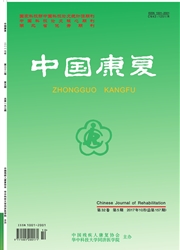

 中文摘要:
中文摘要:
The effect of high-frequency repetitive transcranial magnetic stimulation(r TMS) on potassium-chloride cotransporter-2(KCC2) protein expression following spinal cord injury(SCI) and the action mechanism were investigated. SCI models were established in SD rats. Five groups were set up randomly: normal control group, SCI 7-day(7 D) model group, SCI 14-day(14 D) model group, SCI-7 DrTMS group and SCI-14 DrTMS group(n=5 each). The rats in SCI rTMS groups were treated with 10 Hz rTMS from 8 th day and 15 th day after SCI respectively, once every day, 5 days every week, a total of 4 weeks. After the model establishment, motor recovery and spasticity alleviation were evaluated with BBB scale once a week till the end of treatment. Finally, different parts of tissues were dissected out for detection of variations of KCC2 protein using Western blotting and polymerase chain reaction(PCR) technique. The results showed that the BBS scores after treatment were significantly higher in SCI-7 DrTMS group than in SCI-14 DrTMS group(P<0.05). As compared with normal control groups, The KCC2 protein in SCI model groups was down-regulated after SCI, and the decrease was much more significant in SCI-14 D model group than in SCI-7 D group(P<0.05). As compared with SCI model groups, KCC2 protein in rTMS groups was up-regulated after the treatment(P<0.05). The up-regulation of KCC2 protein content and expression was more obvious in SCI-7 DrTMS group than in SCI-14 DrTMS group(P<0.05). It was concluded that 10 Hz rTMS can alleviate spasticity in rats with SCI, which might be attributed to the up-regulation of KCC2 protein. It was also suggested that the high-frequency rTMS treatment after SCI at early stage might achieve more satisfactory curative effectiveness.
 英文摘要:
英文摘要:
The effect of high-frequency repetitive transcranial magnetic stimulation (rTMS) on potassium- chloride cotransporter-2 (KCC2) protein expression following spinal cord injury (SCI) and the action mechanism were investigated. SCI models were established in SD rats. Five groups were set up randomly: normal control group, SCI 7-day (7D) model group, SCI 14-day (14D) model group, SCI-7D rTMS group and SCI-14D rTMS group (n=5 each). The rats in SCI rTMS groups were treated with 10 Hz rTMS from 8th day and 15th day after SCI respectively, once every day, 5 days every week, a total of 4 weeks. After the model establishment, motor recovery and spasticity alleviation were evaluated with BBB scale once a week till the end of treatment. Finally, different parts of tissues were dissected out for detection of variations of KCC2 protein using Western blotting and polymerase chain reaction (PCR) technique. The results showed that the BBS scores after treatment were significantly higher in SCI-7D rTMS group than in SCI-14D rTMS group (P < 0.05). As compared with normal control groups, The KCC2 protein in SCI model groups was down-regulated after SCI, and the decrease was much more significant in SCI-14D model group than in SCI-7D group (P < 0.05). As compared with SCI model groups, KCC2 protein in rTMS groups was up-regulated after the treatment (P < 0.05). The up-regulation of KCC2 protein content and expression was more obvious in SCI-7D rTMS group than in SCI-14D rTMS group (P < 0.05). It was concluded that 10 Hz rTMS can alleviate spasticity in rats with SCI, which might be attributed to the up-regulation of KCC2 protein. It was also suggested that the high-frequency rTMS treatment after SCI at early stage might achieve more satisfactory curative effectiveness.
 同期刊论文项目
同期刊论文项目
 同项目期刊论文
同项目期刊论文
 期刊信息
期刊信息
